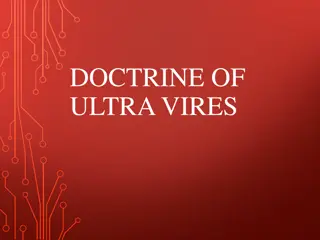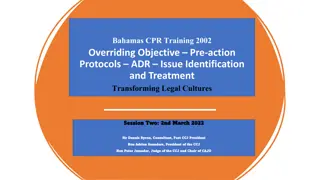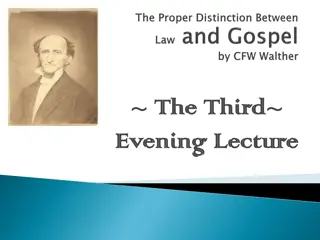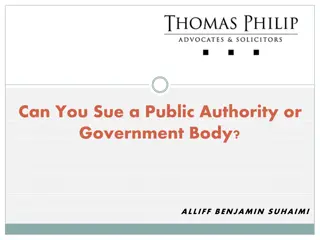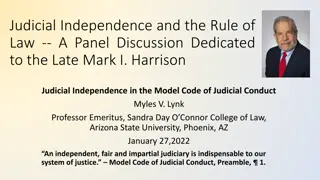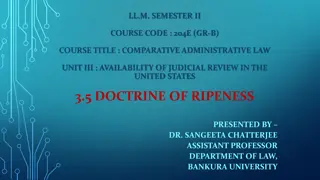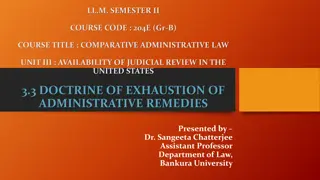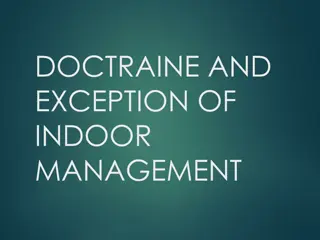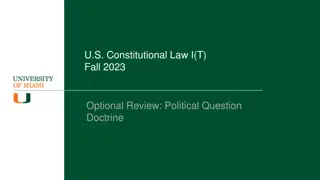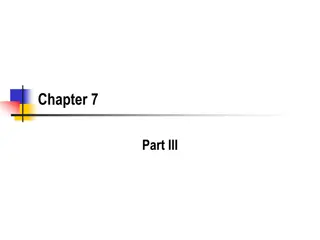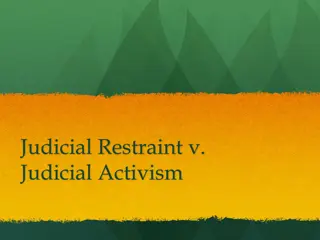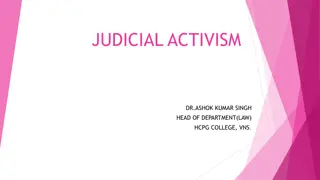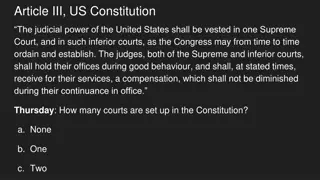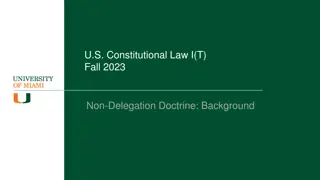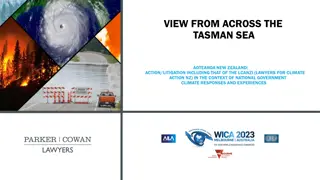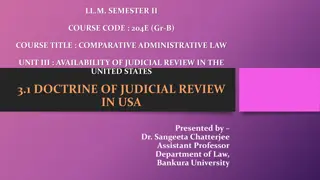Understanding the Doctrine of Standing in US Judicial Review
The doctrine of standing in United States judicial review is explained, focusing on the capacity of a plaintiff to seek judicial review based on injury-in-fact, causation, and redressability. The requirements of the standing doctrine and its relation to Article III of the US Constitution are discussed, covering how courts assess standing in environmental impact cases and under the Freedom of Information Act. The Chenery doctrine regarding agency decisions and the areas of relaxation in standing requirements are also outlined.
Download Presentation

Please find below an Image/Link to download the presentation.
The content on the website is provided AS IS for your information and personal use only. It may not be sold, licensed, or shared on other websites without obtaining consent from the author. Download presentation by click this link. If you encounter any issues during the download, it is possible that the publisher has removed the file from their server.
E N D
Presentation Transcript
LL.M. SEMESTER II COURSE CODE : 204E (Gr-B) COURSE TITLE : COMPARATIVE ADMINISTRATIVE LAW UNIT III : AVAILABILITY OF JUDICIAL REVIEW IN THE UNITED STATES 3.4 DOCTRINE OF STANDING Presented by Dr. Sangeeta Chatterjee Assistant Professor Department of Law, Bankura University
There is no recognition of public interest standing in the United States. But a brief overview of contemporary standing doctrine and judicial review will provide an idea about the doctrine. Judicial review of statutory law in the United States comes from the Administrative Procedure Act ( APA ). The right to review in the APA states, A person suffering legal wrong because of agency action, or adversely affected or aggrieved by agency action within the meaning of a relevant statute, is entitled to judicial review thereof. Such person who suffered a legal wrong or is otherwise adversely affected by an agency action must then havestanding. INTRODUCTION
Doctrine of Standing denotes the capacity of a plaintiff to stand before the Court in USA for Judicial Review. According to the U.S. Supreme Court, it is very similar to the traditional common law understanding of locus standi. When a person suffers from legal wrong owing to an adverse agency action within the meaning of a relevant statute, then he or she is entitled to judicial review thereof. Such person who has suffered a legal wrong has the capacity of standing before a court for judicial review. DOCTRINE OF STANDING
Injury-in-Fact Causation Redressability Generalized Grievances REQUIREMENTS OF THE DOCTRINE
The standing doctrine has many strands, and Article III does not compel all of them. The Supreme Court has also imposed other prudential standing requirements to limit the discretion of the judiciary. STANDING DOCTRINE AND ARTICLE III The which requires those who seek judicial review of federal demonstrate that within the zone of interests that Congress intended when it enacted the enabling statute, is confessedly prudential. zone of interests requirement, agency they action to arguably fall
Environmental Impact Statements The Freedom of Information Act and Informational Injury The Chenery doctrine holds that reviewing courts may uphold agency decisions only on grounds specifically relied upon by the agency. One basic corollary of this rule is that the only remedy a reviewing provide is to vacate the agency s decision and order the agency to reconsider it on other grounds. Doctrine - The AREAS OF RELAXATION court can usually
In Lujan v. Defenders of Wildlife, 1992, the applicants ( Defenders ) sought judicial review of the Secretary of the Interior s interpretation of section 7(a)(2) of the Endangered Species Act which requires federal agencies to insure their activities are not likely to jeopardize endangered or threatened wildlife to apply only to actions within the United States and on the high seas. EVOLUTION IN USA For standing purposes, the Defenders claimed injury was that the lack of consultation on projects funded abroad would increase the rate of extinction of endangered species.
One of the Defenders primary objectives was the protection of wildlife which is also one of the objectives of the Endangered Species Act. However, the injury-in-fact requirement means that the plaintiff must be harmed directly by the agency action. The Court also held that the affidavits submitted by members who had an interest in viewing the threatened animals did not satisfy the injury-in-fact requirement because the members did not have concrete plans to return to the affected geographic areas. EVOLUTION IN USA The majority clarified that an individual who worked with the threatened species in the location affected by the funding projects would plausibly havestanding.
Public Interest Standing would not overburden the U.S. Judicial System. Public Interest Standing would not abridge the Separation of Powers Doctrine. Determining Genuine Interest would not involve policy judgments by the Judiciary. MERITS OF THE DOCTRINE an Applicant s
All the three doctrines are available in USA for using against Judicial Review in thecourts. Mainly these instruments are used to prevent unnecessary and excessive Judicial Review. These doctrines are created to provide a second chance of survival to theadministrativeagencies. Exhaustion is used to finish all possible remedies by an administrativeagency. Ripeness is used to determine the maturity or fitness of a case. Standing is used to determine fitness or standing capacityof the applicant. Ripeness is the fitness criteria of the case, but Standing is the fitness criteriaof the party. EXHAUSTION, RIPENESS AND STANDING
Standing is about separation of powers. But over emphasis of the separation of powers is apt to obscure the no less important system of checks and balances. While the Court has long insisted that the best and only way to ensure that federal courts do not exceed their constitutional powers is to insist on a strict regime of injury-in-fact, causation, redressability, it is time for the Court to explain why its procedural rights cases sometimes stray from that regime. CONCLUSION and
1. Jeffrey T. Hammons, Public Interest Standing and Judicial Review of Environmental Matters: A Comparative Approach, Columbia Journal of Environmental Law, Vol. 41 (3), 2016. 2. Ann Woolhandler & Caleb Nelson, Does History Defeat Standing Doctrine?, Michigan Law Review, Vol. 102 (4), 2004, https://repository.law.umich.edu/mlr/vol102/iss 4/2, visited on 29.05.2020. REFERENCE : 3. Evan Tsen Lee & Josephine Mason Ellis, The Standing Doctrine s Dirty Little Secret, Northwestern University Law Review, Vol. 107 (1), 2012.




